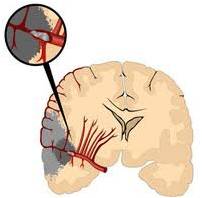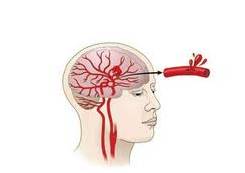What is stroke?
A stroke, sometimes called a brain attack, occurs when the blood supply to part of the brain is blocked or when a blood vessel in the brain bursts. In either case, parts of the brain become damaged or die.
There are two types of stroke.
An ischemic stroke occurs when blood clots or other particles block the blood vessels to the brain. Fatty deposits called plaque can also cause blockages by building up in the blood vessels.
The second type, hemorrhagic stroke, occurs when a blood vessel bursts in the brain. Blood accumulates and compresses the surrounding brain tissue.
What is a “mini-stroke” or TIA?
A “mini-stroke” refers to a transient ischemic attack (TIA). In a TIA, there is a short-term reduction in blood flow to the brain. This causes temporary stroke symptoms (often just for a few minutes) such as weakness or tingling in an arm or leg. TIAs don’t cause brain damage, but they are important warning signs that a person is at risk of having a stroke. If you have a TIA, you should seek medical care right away to prevent a full stroke.
What are the symptoms of stroke?
Major signs of stroke include:
- Sudden numbness or weakness of the face, arm, or leg.
- Sudden confusion or trouble speaking or understanding others.
- Sudden trouble seeing in one or both eyes.
- Sudden dizziness, trouble walking, or loss of balance or coordination.
- Sudden severe headache with no known cause.
What should you do if you think someone is having a stroke?
If you think you or someone is having a stroke, call the nearest hospital immediately.
Why do you need to act fast?
Getting fast medical treatment lowers your risk of disability or even death. That’s why it’s important to recognize the symptoms and to get help right away.
What are the risk factors for stroke?
Several conditions and certain lifestyle choices can put people at higher risk for stroke. The most important risk factors are:
- High blood pressure
- Heart disease
- Diabetes
- Cigarette smoking
- Prior stroke
- Stroke or heart disease in parents or blood relatives
Age is also a factor: the chance of having a stroke more than doubles for each decade of life after age 55.
What can you do to reduce your risk?
You can take several steps to reduce your risk for stroke:
- Eat healthy diet.
- Maintain a healthy weight.
- Be physically active.
- Don’t smoke.
- Limit alcohol use.
- Prevent or treat high cholesterol.
- Prevent or treat high blood pressure.
- Prevent or treat diabetes.
Talk with your doctor about the best ways to lower your risk for stroke.
How many Indians suffer from stroke?
During the last decade, prevalence rate of stroke was 250 to 350 per 100,000 persons. The ratio of cerebral infarct to hemorrhage was 2.21. Hypertension was the most important risk factor. Stroke represented 1.2% of total deaths in India. Stroke is also a leading cause of serious long-term disability.
What is the aftermath of stroke?
Stroke is a leading cause of serious, long-term disability in India.
- 14% of persons who survive a first stroke or TIA may have another stroke within 1 year.
- 22% of men and 25% of women who have an initial stroke die within a year. This percentage is higher among people age 65 and older.
- 51% of men and 53% of women under age 65 who have a stroke die within 8 years.
- 50–70% of stroke survivors regain functional independence.
- 15–30% are permanently disabled.
- 20% require institutional care at 3 months after onset.
- 19% may have difficulty in speaking.
- The length of time to recover from a stroke depends on its severity.
What will the doctor do if he or she suspects a stroke?
Typically a doctor will monitor a patient and perform neurological tests to assess whether any damage has occurred. If there is evidence a person experienced an attack then the doctor will look to find the cause and location of the problem (like a blood clot) so they can then treat it as soon as possible. A physician might order a CT scan or MRI of Brain to look for any clots or bleeding that may occur in
the brain.
How is stroke treated in a hospital?
Your specialized stroke care begins the moment you enter a hospital. Suspected stroke patients go immediately to the Radiology Department for a CT scan of the head, and the results are obtained from the radiologist within minutes of completion. While the patient is still in the ED, the emergency physician will make contact with a neurologist based upon the results of the patient’s CT scan. Stroke care decisions are made within 45 minutes of arrival based upon the CT scan, lab results and patient’s overall condition like pulse, blood pressure, blood sugar levels, breathing, etc.
Timing is of particular importance for stroke patients as those who present within three hours of symptom onset are prime candidates for the drug t-PA. T-PA is a game-changing stroke treatment that helps dissolves clots and restores blood flow to the brain tissue that is dying from lack of oxygen.
The nurses and physicians within the Emergency Department of our Hospital follow a specialized set of international guidelines, which are reviewed on a regular basis by specialists worldwide.

